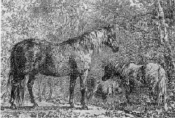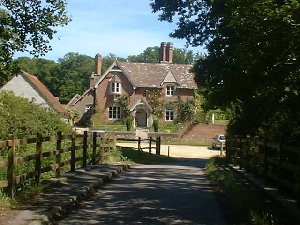|
A Man With A Vision
William Gilpin (1724-1804) had the traditional upbringing of
a member of the British upper class in the eighteenth century. Born in a castle, he was the bearer of a respected family name
and recipient of an excellent education. With two degrees from Oxford, and the opportunity to use family influences to gain
ready employment, William seemed destined for a successful career in the church. Indeed, after graduating with his M.A. in
1748, William took up a curacy in London. His six years at Oxford had prepared him for a profession; however, Gilpin was not
convinced that the system of teaching used was the most effective. He had ideas of how to do it better and decided to put
them into practice. In 1752 he moved to Cheam, Surrey, and became master of the Cheam school.
In his school, Gilpin began to institute his progressive reforms. He involved
his students in devising their own discipline system, encouraged the learning of practical skills, such as gardening and business
techniques, and instilled in them a sense of community service. The school was a success and established Gilpin's reputation
as an excellent teacher. Unfortunately, it was not instantly a financial success. To raise the necessary funds to pay the
last of his Oxford debt, Gilpin decided to write a biography of his grandfather, John Bernard Gilpin--Apostle of the
North. The venture was well received and launched Gilpin's parallel career as a biographer of English religious reformers.
Throughout his career, Gilpin produced nine subsequent biographies.
During his summer holidays, Gilpin began taking walking tours in the English countryside.
He recorded his trips with sketches and a running commentary. On the urging of his friends, Gilpin published the account of
his tour to the Wye River and South Wales in 1782. He presented the countryside in an exciting new way and the British audience
was captivated by his images. They wanted more. Gilpin obliged with illustrated accounts of six more tours, four published
during his lifetime and two posthumously. His aesthetic attitude to landscape, which he called "picturesque," had a major
impact on the British imagination and helped shape a movement that defined English taste for the next fifty years.
In 1777, Gilpin retired from his strenuous teaching position and returned to the
ministry. With the assistance of one of his former students, he acquired the vicarage of Boldre, Hampshire. He then directed
his attention to improving conditions in his parish by promoting the establishment of a new poor house and by personally building
and providing an endowment for a parish school. During this period, Gilpin also published collections of his sermons and several
works intended for religious education. As with his previous writings, his religious work found an appreciative audience.
In the latter part of his life, Gilpin auctioned his original drawings and used the funds to further endow his parish school.
William Gilpin died in 1804 after a long and productive life. He had achieved respect and admiration for his accomplishments
in five separate spheres --education, biography, art theory, religion, and philanthropy.

|
| Illustration of New Forest Ponies. from "Remarks on Forest Scenery by William Gilpin, 1791 |
 |
 |
|
"It is allowed to our sovereign lord the king, in respect of his continual care, and labour, for the preservation of
the whole realm, among other privileges, this prerogative, to have his places of recreation and pastime, whatsoever he will
appoint. For as it is at the liberty, and the pleasure of his to the reserve the wild beast, and the game to himself, for
his only delight and pleasure, so he may also at his will and pleasure, make a forest for them to abide in."
|
|
Manwood (16th century), quoted in William Gilpin, 1791.
"Remarks on Forest Scenery", Book III, p 9
|
|
 |
 |
|
 |
|

to be found at the
Devon Library
and Information Services
Local
Studies Service
A New Forest
Squatters Settlement
1700 - 1900
an entry in the
Norton Anthology of
English Literature
a fairly detailed entry
in Wikipedia
with links to William Gilpin
Hampshire's website.
The New Forest is a medieval
royal hunting area
in the south of England
our website about this
incredibly beautiful place
the enlarged and completely
redesigned museum is now
open
in Boldre, Hampshire, England
William Gilpin School has
a long history of service to the
community.
The school was originally founded
by the Reverend William Gilpin in 1791
"for the education of the sons and daughters
of the day labourers of the parish."
By 1870 the original building on the
corner of School Lane was too small
for the needs of the village and the present
building was opened in 1875.
more William Gilpin links
from the University of Alberta
in Canada
the geography and
architecture of landscape
from a subjective point of view, using
elements of myth, fantasy
or the picturesque.
|
 |
|
|
 |
|
|
|

